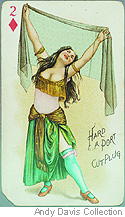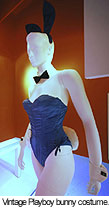 With its Fifth Avenue address, its liquid-crystal viewing screens, its audio tours and gift shop, the new Museum of Sex matches every expectation for a modern museum-except for that name. Announce you've been to the Museum of Sex, and your audience will snigger, try out a few jokes (Most frequent: "Another year older and I'm going to be in there") and frown before asking, "What the hell is it?"
With its Fifth Avenue address, its liquid-crystal viewing screens, its audio tours and gift shop, the new Museum of Sex matches every expectation for a modern museum-except for that name. Announce you've been to the Museum of Sex, and your audience will snigger, try out a few jokes (Most frequent: "Another year older and I'm going to be in there") and frown before asking, "What the hell is it?""Museum" is a term in play, as the linguists would say. What we look at and how we relate to it is changing. Americans used to line up to see rare objects, like Rembrandt's "Night Watch" or King Tut's gold. Now we are invited to examine artifacts--the more mundane the better--that connect us with the struggles of people not unlike us. With high-tech interactivity and documentary footage, new museums like the Holocaust Memorial in Washington, D.C. or the Ellis Island restoration are aimed at heightening our consciousness, not our taste.
The Museum of Sex pushes this envelope--so much that New York State officials refused to give it nonprofit status as a museum. But on its face the it's no less a museum than any other in this new category. "We're between the Whitney [Museum of American Art] and the Holocaust Memorial," says founder Dan Gluck. "We want to create something that's experiential."
Sex, however, turns out to be a slippery kind of experience. Sex often comes with other ideas attached--ideas about identity or freedom or transgression. The Museum of Sex recognizes this, and wants badly to show us how these having sex has changed us through history, but too often what's on display is not sex but porn, a particular kind of sex that for all its transgressive power, can leave viewers convinced after an hour or two of observation that sex is sometimes just sex.
 It's what the exhibit doesn't tell that's curious. As the battle between the vice squad on the one hand and the sex industry on the other plays out, we never see how good old marital, pre-marital and extra-marital sex fits in. We don't see sex as it truly lives in the public square: in movies, television shows, advertising and New Yorker cartoons. We get the impression that sex, once closeted with the gays, the fetishists and the nudists, was called into the mainstream by the great sexual deluge of the '70s.
It's what the exhibit doesn't tell that's curious. As the battle between the vice squad on the one hand and the sex industry on the other plays out, we never see how good old marital, pre-marital and extra-marital sex fits in. We don't see sex as it truly lives in the public square: in movies, television shows, advertising and New Yorker cartoons. We get the impression that sex, once closeted with the gays, the fetishists and the nudists, was called into the mainstream by the great sexual deluge of the '70s.
The heroes of this story, inevitably, are those who give the hungry masses sex to look at. This leads to Delores del Rio, for instance, being honored as "the first woman of color to achieve a following" as a porn star. As we watch del Rio have sex on four screens at once, the achievement seems pretty dubious. The exhibit notes at one point that the Victorian Comstock Laws were aimed not at the prohibiting sex itself, but images of it. "NYC Sex" suffers the same tic. We are constantly faced with printed and projected images of sex. What we never hear about is the sex most of us know--sex as a medium that expresses love, freedom, control, even hate.
Some museums, like the Metropolitan Museum of Art 55 blocks uptown, are temples to their subjects; others, like the Smithsonian, are great national attics. The more recent ones, like the Holocaust Memorial, provide a balm of memory. The Museum of Sex is a laboratory, objectifying sex for the purpose of examining it. Implicit is the idea that we've conquered and caged our venality. But even as we view the exhibits here, we can feel the creature Eros oozing out of our--and the museum's--grasp. The museum's maiden exhibit, "NYC Sex: How New York City Transformed Sex in America" is a timeline of how the shadow world of sex-strippers, prostitutes, group-sex clubs and pornography on film--irresistibly bubbled to the surface of city life. In this history, illicit sex finds its way out of bawdy houses to trendy, if not exactly chic, anything-goes emporia like Plato's Retreat. Closeted homosexuals fought back against police raids to become champions of gay liberation. The exhibit succeeds in telling this story, doing an especially good job of showing how "art" photos, science exhibits and morality tales about white slavery were used to smuggle sex into respectable hands.
Gluck got the idea for a sex museum in 1997, about the time he bought the Fifth Avenue building with proceeds from selling his software company. He wanted, he says, "to convey the idea that sexuality in all its forms has an important place in our cultural heritage."
This mission statement shows the influence of Camille Paglia, whose 1990 book "Sexual Personae" found the influence of neurotic and repressed sexuality in nearly every nook and cranny of Western culture. Sex is for Paglia what class warfare is for Marxists: it drives culture and our efforts to dignify our motivations as more than sexual only get us snarled. The antidote is to rid sex of its taboo, so we can see it clearly for the powerful force it is. "Sexuality has become a field of study," Gluck says. "But there's never been a way to reach out to the public with these ideas." Paglia, who Gluck had first read in college, was the first person he contacted when he was putting together his proposal.
But when Gluck's project first made the papers, the academic niceties were lost. The announcement about the planned museum got swept up into the media frenzy over then Mayor Rudolph Giuliani's campaign to rid the city of smut shops and topless bars. The Catholic League quickly condemned the idea of the museum, and even liberal commentators greeted it with a knowing smirk. "There were a lot of misunderstandings before we opened," says Gluck.
To this day, Gluck has to refute charges that the museum is simply glorified pornography. He points out that the museum's bylaws prohibit getting financial support from anyone in adult entertainment. And though the museum is open only to only persons 18 years or older Gluck firmly rejects any notion the exhibits are designed to appeal to prurient interests. In his words, they "tell all we need to tell," and no more.

